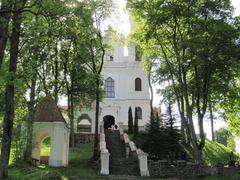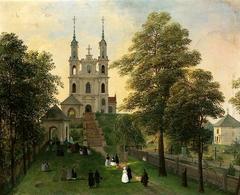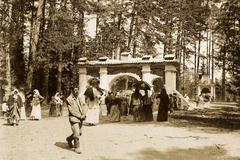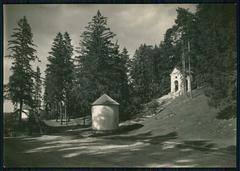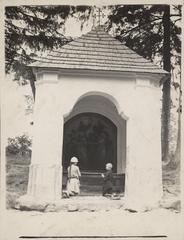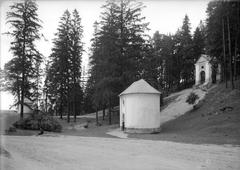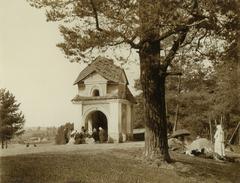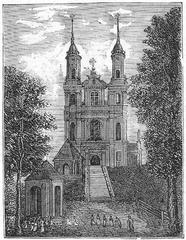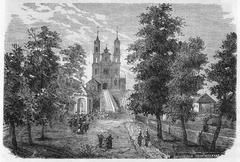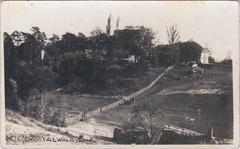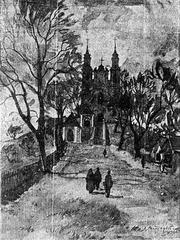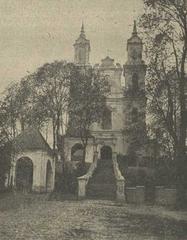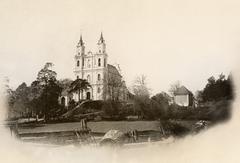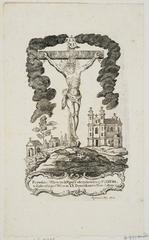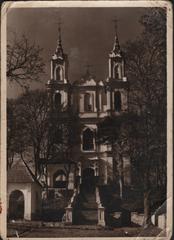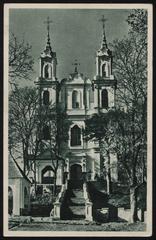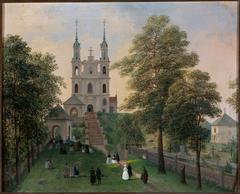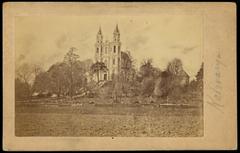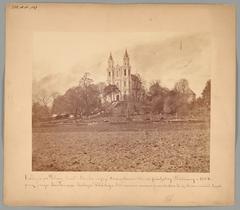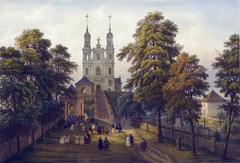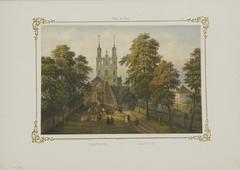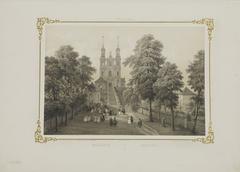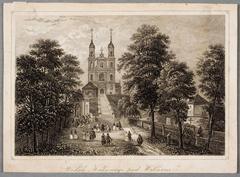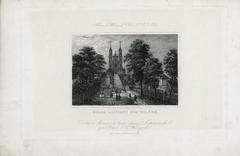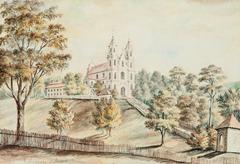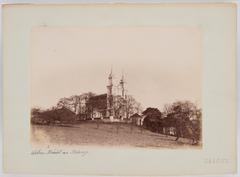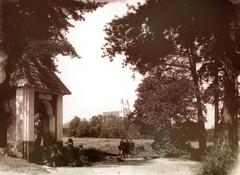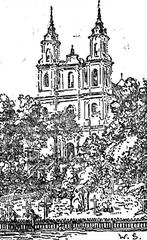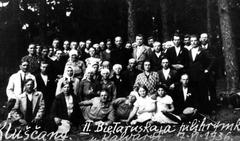
Church of the Discovery of the Holy Cross, Vilnius: Visiting Hours, Tickets & Comprehensive Visitor Guide
Date: 15/06/2025
Introduction
Nestled in the scenic Verkiai district of Vilnius, Lithuania, the Church of the Discovery of the Holy Cross (Šv. Kryžiaus Atradimo bažnyčia) stands as a testament to centuries of faith, artistic achievement, and cultural resilience. Dating back to the 17th century, this Baroque landmark is the spiritual heart of the Vilnius Calvary pilgrimage route, a unique ensemble inspired by Jerusalem’s Via Dolorosa. Having survived wars, occupation, and Soviet suppression, the church is now restored and welcomes visitors to explore its rich history, ornate interior, and tranquil surroundings. This detailed guide provides everything you need to know—history, architecture, visiting hours, ticketing, accessibility, travel tips, and nearby attractions—ensuring a rewarding experience for pilgrims, culture seekers, and travelers alike (Vilnensis Parish; Go Vilnius; True Lithuania).
Table of Contents
- Historical Background
- Religious and Cultural Significance
- Artistic and Architectural Features
- Visitor Information
- Community Role & Preservation
- Frequently Asked Questions (FAQ)
- Visual Highlights
- Related Links
- Conclusion & Call to Action
- References
Historical Background
Origins and Foundation
The Church of the Discovery of the Holy Cross was established in the 17th century, a period marked by the Catholic Counter-Reformation. Its founding in 1662 by Bishop Jerzy Biallozor was part of a broader initiative to reinforce Catholic devotion in the Grand Duchy of Lithuania. The church and its surrounding Calvary complex were designed as a local pilgrimage route, replicating the spiritual journey of Christ’s Passion in Jerusalem. Consecrated in 1669, the church quickly grew in prominence, attracting pilgrims from across the region (Vilnensis Parish).
Architectural Evolution
Initially constructed in the Baroque style, the church features a single nave, high altar, and elaborate stucco work. Over time, the complex expanded: the 18th century saw the addition of numerous chapels and the bell tower, while the 19th century brought further artistic enhancements. The Soviet era was devastating—many Calvary chapels were demolished and the church was repurposed for secular use. Restoration began in the late 1980s, culminating in reconsecration and the gradual rebuilding of the Calvary stations (Vilnensis Parish).
Religious and Cultural Significance
Serving as the centerpiece of Vilnius Calvary, the church is one of Lithuania’s foremost pilgrimage sites. Its 35 stations, stretching over 7 kilometers, symbolize the Passion of Christ and provide space for prayer and reflection. The annual Feast of the Discovery of the Holy Cross on May 3rd draws thousands for processions and liturgical celebrations. Beyond its religious role, the church is a symbol of Lithuanian endurance and identity, withstanding centuries of adversity and emerging as a beacon of cultural heritage (True Lithuania; Go Vilnius).
Artistic and Architectural Features
Baroque Splendor
The church’s façade is a Baroque masterpiece, adorned with pilasters, decorative cornices, and a commanding bell tower. Inside, visitors encounter a richly decorated sanctuary with a main altar dedicated to the Holy Cross, side altars featuring saintly sculptures, and vaulted ceilings painted with biblical frescoes. Notably, three stations of the Calvary are integrated into the church’s structure: Stations 31 and 33 are on the exterior, while Station 32 (the Crucifixion) forms the main altar.
Monastic Complex
Adjacent to the church is a former Dominican monastery, with a refectory and ornate sacristy (added in 1793) featuring intricate stucco work. The complex’s spatial organization supports both worship and pilgrimage, and its restoration has brought back much of its former grandeur.
Calvary Stations and Natural Setting
The Calvary chapels, reconstructed in recent decades, are harmoniously set within Verkiai Regional Park. Hills named Golgota, Marija, Sionas, and Mount of Olives, along with the Cedronas stream, evoke the sacred geography of Jerusalem.
Visitor Information
Visiting Hours & Tickets
- Opening Hours: Daily from 9:00 AM to 6:00 PM. Hours may vary during religious holidays; check the official website for updates.
- Admission: Free; donations are encouraged to support restoration and maintenance.
- Guided Tours: Available by prior arrangement, especially during peak seasons or special events.
Guided Tours & Accessibility
- Tours: Expert guides provide insights into the church’s architecture, history, and spiritual significance.
- Accessibility: The church and much of the Calvary route are accessible, with ramps and resting areas. Some outdoor stations have uneven terrain; the shorter 2 km Mažosios Kalvarijos route is recommended for visitors with limited mobility (Go Vilnius).
How to Get There
- By Public Transport: Buses 2, 10, and 48 serve stops near Kalvarijų street; the church is a short walk from the stops.
- By Car: Parking is available nearby.
- On Foot/Bike: The site is within reach of central Vilnius and offers scenic walking and cycling routes through Verkiai Regional Park.
Nearby Attractions
- Verkiai Regional Park: Offers trails, natural beauty, and historic sites.
- Verkiai Palace: A short distance away, the palace is a fine example of Lithuanian classical architecture.
- Vilnius Old Town: UNESCO World Heritage Site, easily accessible by public transport.
Events & Special Services
- Feast Days: The annual Feast of the Discovery of the Holy Cross (May 3) and Holy Week processions are major events.
- Masses: Regular Catholic services; check the parish schedule for times.
- Concerts: The church occasionally hosts sacred music performances.
Community Role & Preservation
The church remains an active parish center, offering regular Mass, sacraments, pastoral care, and community outreach. Restoration work continues, focusing on structural integrity, artwork conservation, and visitor accessibility. The site is recognized as a national cultural monument, protected and supported by both church and state.
Frequently Asked Questions (FAQ)
Q: What are the visiting hours?
A: Daily from 9:00 AM to 6:00 PM; check for changes during holidays.
Q: Is there an entrance fee?
A: No, entry is free, but donations are appreciated.
Q: Are guided tours available?
A: Yes, tours can be arranged via the parish website.
Q: Is the site accessible for visitors with disabilities?
A: The main areas are accessible; some outdoor stations may be challenging.
Q: How can I get there using public transport?
A: Buses 2, 10, and 48 stop nearby.
Q: Can I take photographs?
A: Photography is generally allowed, but discretion is advised during services.
Q: Are there special services or events for visitors?
A: Yes, especially during Holy Week and the Feast of the Discovery of the Holy Cross.
Q: Is there a dress code?
A: Modest attire is recommended, especially during services.
Visual Highlights
- Baroque façade and twin bell towers
- Ornate main altar and side chapels
- Restored Calvary chapels set in parkland
- Interior frescoes and stucco work
- Venerated relics, including the True Cross
Find images and virtual tours on the Vilnensis Parish website and Go Vilnius.
Related Links
- Vilnensis Parish: Official Site
- Go Vilnius: Verkiai Regional Park
- True Lithuania: Religious Sites
- Vilnius Tourism
- Verkiai Regional Park
Conclusion & Call to Action
The Church of the Discovery of the Holy Cross is a remarkable blend of Baroque artistry, spiritual tradition, and national resilience. With free entry, generous visiting hours, and a wealth of historical and religious treasures, it is an essential stop in Vilnius for both spiritual seekers and cultural explorers. Plan your visit, attend a special event, or simply take time to reflect amid the church’s tranquil surroundings. For audio guides, maps, and up-to-date information, download the Audiala app and follow us on social media for the latest news on Vilnius’s cultural heritage.

